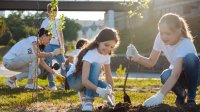Hands-On Learning and the SDGs
A look at a few ways to incorporate the U.N.’s Sustainable Development Goals across the curriculum.
Your content has been saved!
Go to My Saved Content.The Sustainable Development Goals (SDGs) are a road map created by the United Nations for world development and a better future for all. The goals were established in 2015 with the aim of reaching them by 2030, so this is the halfway mark and a great time to think about what we’re doing to help achieve these goals.
As educators, choosing to teach about the 17 Sustainable Development Goals directly supports targets within the Quality Education SDG, which is Goal 4. According to UNESCO, “Education is both a goal in itself and a means for attaining all the other SDGs. It is not only an integral part of sustainable development, but also a key enabler for it. That is why education represents an essential strategy in the pursuit of the SDGs.”
Including the SDGs in your teaching and learning
There are three main ways that you can include learning about the Sustainable Development Goals in your school activities: extending current curriculum topics, adding specific SDG units or making connections to school events, and national/global commemorations.
With the many opportunities to enhance current topics by learning about SDGs, it should be possible to map the 17 SDGs to either subjects or themes. It’s best to complete this as a whole-staff activity to consider age-appropriateness and accessibility.
A good starting point for younger learners (kindergarten through second grade), for instance, is learning about the SDGs connected to experiences they’re more likely to have had—for example, Goal 3, Good Health and Well-Being, as children in this grade range may have visited doctors, dentists, or hospitals. Extend students’ learning about themselves in science or health class, including nutrition and hygiene, to consider challenges for those with a lack of access to clean water or sufficient food. A simple experiment with glitter or a spray that only shows up under ultraviolet light can simulate the spread of germs and how water and soap are essential tools to fight this.
Simulations can be a great way to develop empathy for those in situations different from ours. Using cookies to show the distribution of food around the world or jugs to demonstrate access to and quality of drinking water can be meaningful and emotive for young learners. Divide the class into equal groups; four to six children works well. Each group receives a specific amount to share; this could range from one crumb of a cookie to a whole bag. Seeing these differences and verbalizing the unfairness of the situation introduces learners to complex challenges such as Zero Hunger, Goal 2.
Upper elementary science topics on electricity and energy production can include Goal 7, Affordable and Clean Energy. This is a good opportunity for learners to realize that the goals are not just focused on developing countries and that industrialized nations, as the major energy users, have a responsibility to develop and use clean energy.
Students can also learn about this SDG through the lens of social studies. A simulation can highlight issues concerning access to affordable energy. Provide each pair or small group with a device; each will have varying amounts of charge. Children will need to decide when to use the device and how to complete tasks without electricity. This highlights issues around accessibility to reliable and affordable energy and the problems that families face with the surge in energy prices.
If you have flexibility in your curriculum, you could introduce new topics. Charities such as Oxfam and WaterAid have educator resources to address specific SDGs. World’s Largest Lesson provides lessons and resources for all SDGs, and some curricula now map the SDGs to units and offer an SDG Challenge series for kindergarten through grade five learners.
An alternative approach would be to map the SDGs to your school calendar, including local, national, and global days of celebration and commemoration. Globally, Earth Day provides the opportunity to learn about SDGs 13 (Climate Action), 14 (Life Below Water), and 15 (Life on Land).
National celebrations such as Martin Luther King Jr. Day can focus on Reduced Inequalities, SDG 10, addressing diversity, equity, inclusion, and justice. Older elementary students could evaluate equality within their school community and suggest improvements or investigate places where equal representation and universal suffrage are not yet a reality. For inspiration on days to celebrate, commemorate, and connect to the SDGs, look at the U.N.’s List of International Days and Weeks. There really is something for everyone.
The impact of including SDGs in education can be personal or far-reaching. Some learners may internalize a new appreciation for the life they lead; others will be driven by empathy to take action. Highlighting the power of one and how anyone can make a difference within school communities, locally, nationally, or globally is essential to maintaining positivity in the face of such complex and daunting issues.
Learners should also understand that they may not necessarily solve the issue, but they can reduce the ways they may be contributing to making the problem worse; this is particularly true with responses to Climate Action, SDG 13. The Lazy Person’s Guide to Saving the World and 170 Actions to Transform Our World identify many actions that anyone can take to support the 17 SDGs.
The Organisation for Economic Co-operation and Development (OECD) now includes global competence in its triannual Programme for International Student Assessment (PISA) evaluations in recognition of the importance of learning about the SDGs. In a report on whether students are ready to thrive in an interconnected world, they acknowledge, “The extent to which those goals will be realised will depend in no small part on what happens in today’s classrooms.”
Teachers and learners around the world have the potential to make a difference today, tomorrow, and far into the future. How will you contribute to creating a better world?
